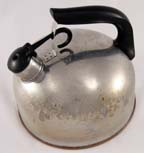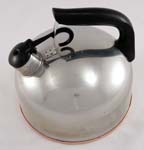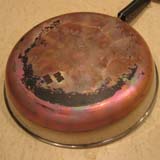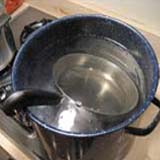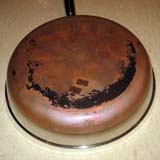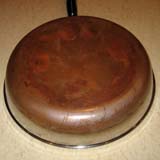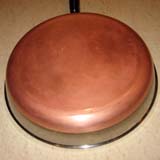Other than replacing worn, unattractive broken and otherwise disfigured parts on your Revere Ware cookware with our new replacement parts, restoring your Revere Ware, treating it right, and keeping it clean is the best way to get the most out of your amazing vintage cookware.
After much research and trial-and-error, we’ve developed our own care & cleaning guide for Revere Ware cookware. You can also take a look at the Care & Cleaning Information we’ve found in vintage brochures and and booklets provided by Revere Ware back in the day.
General Care
Wash the cookware with soap and water and an acrylic scrubbing sponge. If the inside needs more scrubbing power, use a Scotch-Brite pad (the green one). This will dull the inside of your cookware, but the inside will probably end up dull anyways from using metal utensils.
Occasionally, you’ll want to polish the copper, to get it looking shiny again, and to keep anything burnt on from building up. To polish the copper, use a copper polish such as Wrights copper cleaner or Kleen King.
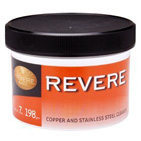
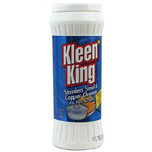
I favor the Revere copper cleaner because it comes as a paste and you simply wet the sponge and work the copper with the paste. For the Kleen King (a powder), I use the same sponge that came with the Revere copper cleaner, apply some to the sponge, work it into a paste with a little water, and then use it just like the Revere copper cleaner. (If you don’t have any professional products, in a pinch you can use salt and vinegar to shine the copper. Works best if you spray vinegar on the copper with a spray bottle, liberally sprinkle salt on, apply some vinegar to your scrubbing sponge, and then scrub away. The salt and vinegar create a reaction that removes the copper oxidation.)
In general, these products will do a nice job at slightly polishing the stainless steel as well. If the stainless steel needs a little more polishing than the copper products offer, use Bar Keepers Friend, which is also very good at removing copper tarnish.
For slight grease stains on the stainless steel (such as from splatter from neighboring pans on the stove) first try Bar Keepers Friend, which is very good at removing baked on grease. If this doesn’t work, fill the pan with water and bring to a boil. While the pan is still hot, apply some copper polish or Bar Keepers Friend to the grease stains and scrub them. If you can do this while leaving the water in the pan, pot, or tea kettle, you will get better results. If you can’t, work the grease stains quickly while the pan is hot and repeat the process until the stains are gone. The heat loosens the grease and allows it to come off with very little work.
|
Kettle before |
Kettle after |
What to Avoid
Never apply cold water to a hot pan. This will likely cause the pan to warp. The only exception is a pressure cooker, which is designed to handle a quick temperature change.
Never use steel wool, SOS, or Brillo pads to clean your cookware. They will leave pieces of themselves behind and cause corrosion.
Don’t put your Revere Ware in the dishwasher. While the metal will hold up fine, the dishwasher can easily ruin the Bakelite parts. See our dishwasher test to understand why this is a bad idea. The heat cycle in particular can be very hard on Bakelite. Note that some Revere Ware care & use guides claims that Revere Ware is dishwasher safe but that handles and other parts may lose their gloss. It is for this reason we do not recommend dishwasher washing. Rubber parts (like gaskets) should never be put in the dishwasher as it will shorten their lives drastically.
Don’t put your Revere Ware in the oven. While in many cases oven baking may be fine, there is a temperature above which the Bakelite handles will start to melt and emit a strong chemical odor. Various Revere Ware guides claims this temperature is 425 degrees F but people have reported this at lower temperatures and if the Bakelite is too close to the broiler, it will be at a much higher temperature than the rest of the oven.
Don’t use your Revere Ware in the microwave unless it is specifically make for it (like the micro-fryer). While some metal cookware (like the micro-fryer) is made to be used in a microwave oven, most Revere Ware cookware has protruding metal handles that will act as a focus for arcing between the insides of the microwave and the pot or pan.
Stove-top Care
Start with medium heat (instead of high) and reduce to low when things start cooking.
Always select an electric plate that is the same size or smaller than the bottom of the pan you are using. When using a gas stove, never have the gas up high enough so that the flames lick out from under the bottom of the pot or pan. This will keep your Bakelite parts from getting burned. If your Bakelite handles are getting hot, your flame is up too high or you are on too large of an electric burner.
Cleaning Abused Cookware
If you’ve burned something on the inside of the pan, here is what to do: Fill the pot or pan with some water and then add a generous amount of automatic dishwasher detergent, and some vinegar. Bring it to a boil, and let it boil for a while, perhaps 15 minutes to a half of an hour. Poke at the burned on crud to see if it has become loose to know when you are done. When it is done, it will quite literally simply slide right off of the pan.
Unfortunately, cleaning the outside of a long-abused pan is much more difficult than the inside because the crud builds up over time, is exposed to direct flame or an extremely hot stove top, and is burned on over and over again. But you can get a significant amount of any burned on crud off the outside of your pot or pan, if not all of it.
Slowly add a large amount of baking soda to boiling water in a large pot. If you are using an 8-quart or larger pot, you could easily use several cups or more of baking soda. Put the pot or pan to be cleaned into the larger pot and let it soak in the boiling water for a while. Take the item being cleaned out of the water every 15 minutes or so and work the crud with an old toothbrush or an acrylic scrubbing sponge. A flat metal spatula can also be good for scraping the flat parts. For more scrubbing power, make a paste out of baking soda and water and use this to scrub. It may take several hours of this to get the pot clean.
In the example below, boiling in the baking soda soak and scrubbing with an acrylic pad doesn’t appear to have done much, but it loosened the burned on crud significantly so that scrubbing with a baking soda paste and loosening with a metal spatula was able to remove all the crud.
|
Before |
Boiling in baking soda |
After baking soda soak |
|
After baking soda scrub |
After polishing |
Hard Water Deposits in Tea Kettles
This is a very common occurrence with a simple remedy. To clean simply combine equal amounts of vinegar and water in the tea kettle and simmer for 10 minutes or so until the hard water deposits flake off. You may need to repeat this treatment. You can also try simply filling your kettle with a 50/50 vinegar/water mixture and letting it stand overnight.

